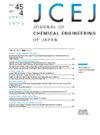Synthesis of Amphiphilic Triblock Copolymers by ATRP and Coalescence Suppression Effect in Suspension Polymerization
IF 1.2
4区 工程技术
Q4 ENGINEERING, CHEMICAL
引用次数: 0
Abstract
In this study, the role of amphiphilic triblock copolymers in suppressing the coalescence of the polymers obtained by suspension polymerization was systematically investigated through the preparation of polymer beads using a common monomer (methyl methacrylate). First, a series of amphiphilic triblock copolymers (PAA-b-PS-b-PAA) were synthesized by atom transfer radical polymerization (ATRP). After synthesizing macroinitiators (PS), the corresponding amphiphilic triblock copolymers were prepared with varied numbers of hydrophobic and hydrophilic units. Subsequently, suspension polymerization was conducted to synthesize polymer beads using the obtained amphiphilic triblock copolymers as polymeric surfactants. We clarified the role of the amphiphilic triblock copolymers in suppressing coalescence of each bead, by observing the size of the monomer droplets prior to suspension polymerization and that of the resulting polymer beads with a microscope.ATRP法合成两亲性三嵌段共聚物及其悬浮聚合抑制聚结作用
在本研究中,通过使用常见单体(甲基丙烯酸甲酯)制备聚合物珠,系统地研究了两亲性三嵌段共聚物在抑制悬浮聚合得到的聚合物聚结中的作用。首先,通过原子转移自由基聚合(ATRP)合成了一系列两亲性三嵌段共聚物(PAA-b-PS-b-PAA)。合成大引发剂(PS)后,制备了具有不同数目的疏水和亲水单元的两亲性三嵌段共聚物。随后,以得到的两亲性三嵌段共聚物为聚合物表面活性剂,进行悬浮聚合合成聚合物珠。通过在悬浮聚合之前观察单体液滴的大小以及用显微镜观察所得聚合物珠的大小,我们澄清了两亲性三嵌段共聚物在抑制每个珠聚结中的作用。
本文章由计算机程序翻译,如有差异,请以英文原文为准。
求助全文
约1分钟内获得全文
求助全文
来源期刊

Journal of Chemical Engineering of Japan
工程技术-工程:化工
CiteScore
1.70
自引率
12.50%
发文量
51
审稿时长
1.9 months
期刊介绍:
The Journal of Chemical Engineering of Japan (JCEJ) is a monthly publication in English of the Society of Chemical Engineers, Japan. The first issue appeared in 1968. JCEJ publishes timely original research in the broad field of chemical engineering ranging from fundamental principles to practical applications. JCEJ is an international research journal and invites your contributions and subscriptions.
All areas of chemical engineering are covered, including:
Physical Properties and Physical Chemistry,
Transport Phenomena and Fluid Engineering,
Particle Engineering,
Separation Engineering,
Thermal Engineering,
Chemical Reaction Engineering,
Process Systems Engineering and Safety,
Biochemical,
Food and Medical Engineering,
Micro and Nano Systems,
Materials Engineering and Interfacial Phenomena,
Energy, Environment, and
Engineering Education.
 求助内容:
求助内容: 应助结果提醒方式:
应助结果提醒方式:


